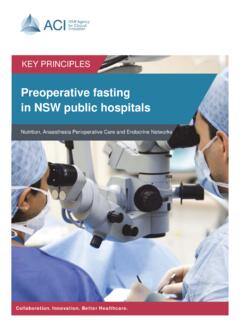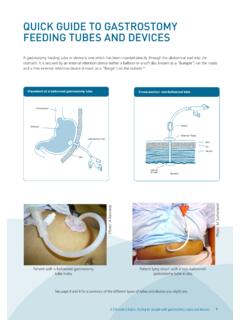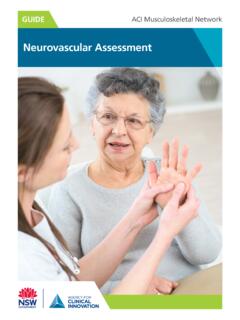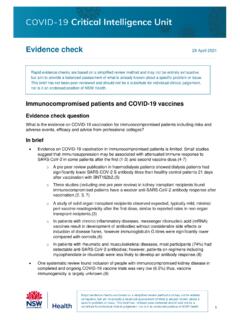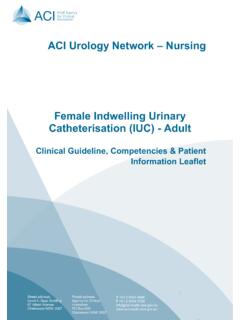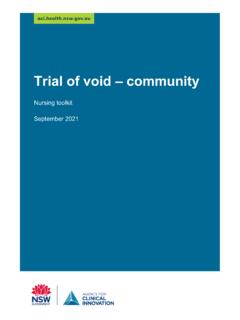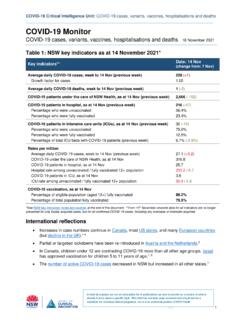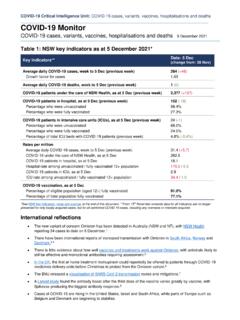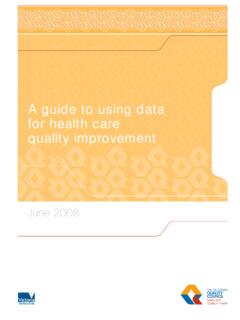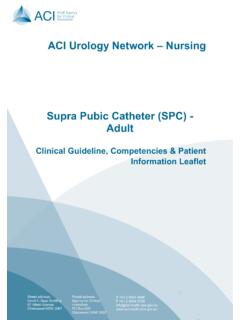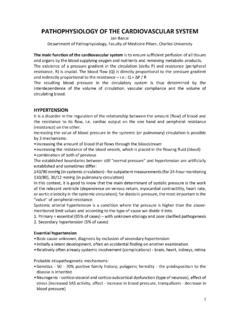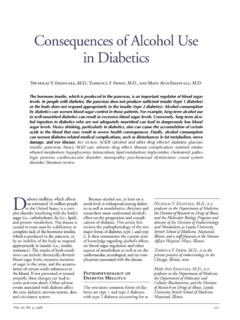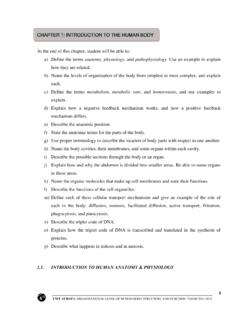Transcription of Dysreflexia for Adults & Adolescents with Spinal Cord …
1 Treatment of Autonomic Dysreflexia for Adults &. Adolescents with Spinal cord Injuries Authors: Dr James Middleton, Director, State Spinal cord Injury Service, NSW Agency for Clinical Innovation. Dr Kumaran Ramakrishnan, Honorary Fellow, Rehabilitation Studies Unit, Sydney Medical School Northern, The University of Sydney, and Consultant Rehabilitation Physician & Senior Lecturer, Department of Rehabilitation Medicine, University Malaya. Dr Ian Cameron, Head of the Rehabilitation Studies Unit, Sydney Medical School Northern, The University of Sydney. Reviewed and updated in 2013 by the authors. AGENCY FOR CLINICAL INNOVATION. Level 4, Sage Building 67 Albert Avenue Chatswood NSW 2067. PO Box 699. Chatswood NSW 2057. T +61 2 9464 4666 | F +61 2 9464 4728.
2 E | Produced by the NSW State Spinal cord Injury Service. SHPN: (ACI) 140038. ISBN: 978-1-74187-972-8. Further copies of this publication can be obtained from the Agency for Clinical Innovation website at: Disclaimer: Content within this publication was accurate at the time of publication. This work is copyright. It may be reproduced in whole or part for study or training purposes subject to the inclusion of an acknowledgment of the source. It may not be reproduced for commercial usage or sale. Reproduction for purposes other than those indicated above, requires written permission from the Agency for Clinical Innovation. Agency for Clinical Innovation 2014. Published: February 2014. HS13-136. ACKNOWLEDGEMENTS. This document was originally published as a fact sheet for the Rural Spinal cord Injury Project (RSCIP), a pilot healthcare program for people with a Spinal cord injury (SCI) conducted within New South Wales involving the collaboration of Prince Henry & Prince of Wales Hospitals, Royal North Shore Hospital, Royal Rehabilitation Centre Sydney, Spinal cord Injuries Australia and the Paraplegic & Quadriplegic Association of NSW.
3 It was first published in June 2002, as part of a series of fact sheets for the RSCIP, being revised in 2005 and 2010, and again now in 2013 by the Rehabilitation Studies Unit, Sydney Medical School Northern. We wish to acknowledge Dr Stella Engel, Dr Sue Rutkowski, Dr Bon San Bonne Lee, Dr Douglas Brown, Prof Anne Tonkin, Dr Mary-Clare Waugh and Dr Komal Adarkar for their contribution to the original and/or subsequent factsheet/s. The project was originally funded by the Motor Accidents Authority of NSW, with 2013 revision funded by the NSW. Agency for Clinical Innovation. The work by Selina Rowe, Manager, NSW Spinal Outreach Service, Royal Rehab, Ryde, and Frances Monypenny, ACI. Network Manager, State Spinal cord Injury Service, Chatswood, NSW, Australia, in coordinating and managing the project to review and update this fact sheet, one of a suite of 10 fact sheets, is acknowledged.
4 All recommendations are for patients with Spinal cord injury as a group. Individual therapeutic decisions must be based on clinical judgment with a detailed knowledge of the individual patient's unique risks and medical history, in conjunction with this resource. 1 Treatment of Autonomic Dysreflexia for Adults & Adolescents with Spinal cord Injuries Table of Contents 1. 1. 3. 2. 4. Common Causes include:.. 4. Symptoms and 5. 3. 6. Initial 6. Further 6. For a person with an indwelling urethral or suprapubic For a person wearing an external collection device or doing intermittent For Faecal 7. Pharmacological 7. Oral Parenteral 4. QUIZ .. 12. 5. 13. 6. ADDITIONAL 14. 2 Treatment of Autonomic Dysreflexia for Adults & Adolescents with Spinal cord Injuries 1.
5 Introduction Autonomic Dysreflexia , also referred to as autonomic hyperreflexia, is a potentially life-threatening condition, which affects individuals with Spinal cord injury (SCI) above the major splanchnic outflow (typically from a lesion at or above the T6 neurological level).(1) It is a condition that many general practitioners and medical and nursing staff in emergency departments have insufficient knowledge about and require further education to rectify this.(2, 3) Delayed diagnosis or untreated autonomic Dysreflexia can result in various significant complications, including stroke, seizures, myocardial ischaemia, and death. In a recent review of 32 cases of death or life-threatening complications, the majority (72%) were related to central nervous system (CNS) complications of stroke or seizures, 22% were cardiovascular-related, and two cases (6%) were complicated by pulmonary oedema.
6 Six of the 7 deaths were due to CNS complications, with the other fatality due to pulmonary oedema.(4). 3 Treatment of Autonomic Dysreflexia for Adults & Adolescents with Spinal cord Injuries 2. pathophysiology Autonomic Dysreflexia results from widespread reflex Figure 1: Pathophysiological mechanisms activity of the sympathetic nervous system below the involved with autonomic Dysreflexia level of injury, triggered by an ascending sensory (usually noxious) stimulus. Following stimulation, overactivity of sympathetic ganglia remains uncontrolled due to isolation of the Spinal cord below the injury from normal regulation by vasomotor centres in the brainstem (refer to Figure 1). Release of substances, such as noradrenaline, cause severe vasoconstriction with skin pallor, piloerection and a sudden rise in blood pressure (BP), which is usually accompanied by a pounding headache.
7 Parasympathetic activity above the level of SCI occurs when the rise in BP is sensed by baroreceptors in the aortic arch and carotid bodies, resulting in compensatory bradycardia (via the vagus nerve). Flushing due to dilatation of blood vessels, which is probably also responsible for headache, and profuse sweating above the level of injury also occur (via sympathetic inhibitory outflow from vasomotor centres). However, both of these mechanisms are insufficient to satisfactorily control paroxysmal hypertension due to massive sympathetically- mediated vasoconstriction of the splanchnic bed.(5). Common Causes trong sensory stimulus from below level of Slesion ( distended bladder) conveyed into include: Spinal cord . Bladder: D.
8 Istended or hyperactive bladder, urinary tract . S ignals transmitted up Spinal cord initiate massive reflex sympathetic activation, causing infection, bladder or kidney stones, urological widespread vasoconstriction (involving splanchnic blood vessels), and resulting in procedure or even inserting a catheter. severe hypertension. Bowel: Constipation, faecal impaction, rectosigmoid gaseous distension, rectal irritation ( enema Brain . from detects a sudden rise in BP (via signals baroreceptors in aortic and carotid or manual evacuation), haemorrhoids. vessels carried in the 9th and 10th cranial nerves). Skin: Ingrown toenail, burns, pressure area, tight clothing. Other: Any irritating stimulus, including fracture, . rain responds and attempts to control B.
9 BP sending descending primary inhibitory impulses from brainstem via Spinal cord epididymoorchitis, distended stomach, sexual (which are blocked). Impulses travelling intercourse, labour or severe menstrual through the vagus nerve cause secondary cramping. Note that autonomic Dysreflexia bradycardia. may be caused iatrogenically by staff clamping a catheter for a procedure such as a bladder ultrasound or kinking catheter by accident in operating theatre during a surgical procedure.(1). 4 Treatment of Autonomic Dysreflexia for Adults & Adolescents with Spinal cord Injuries Symptoms and Signs Table 1: C ommon symptoms and signs of Common symptoms and signs of autonomic Dysreflexia are autonomic Dysreflexia (hyperreflexia). listed in Table 1.
10 Autonomic Dysreflexia in a person with SCI can present in a variety of ways and vary in intensity sudden hypertension from mild discomfort to a severe, life threatening medical pounding headache emergency. Typically, the patient will complain of a pounding bradycardia headache with flushing and profuse sweating above the level of Spinal lesion, with or without other symptoms such flushing/blotching of skin above Spinal injury level as nasal congestion (stuffiness), blurred vision, shortness of profuse sweating above Spinal injury level breath and/or anxiety. Skin pallor and piloerection (goose skin pallor and piloerection below Spinal bumps) can be seen below the level of Spinal lesion. injury level BP is significantly elevated (at least 20 to 40 mmHg chills without fever above normal resting systolic level or 15 to 20 mmHg nasal congestion above resting systolic level in Adolescents ).
